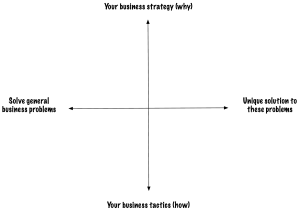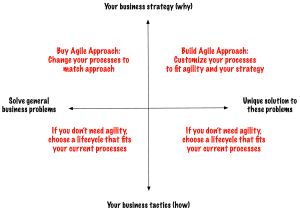Agile Approaches Offer Strategic Advantage; Agile Tools are Tactics, Part 1
A number of my clients confuse their strategic ideas with tactical work. They think that the agile tools they use, such as boards, offer a strategic advantage. So they build or customize their tools. However, they adopt or “install” an agile framework or process without customization. Those actions lead to organizational brittleness. Instead, agile organizations need flexibility, not rigidity.
Let’s first start with how I think about the difference between strategy and tactics.
Differentiate Between Strategy and Tactics
Strategy answers the “why” and “who is this for” questions. I think of these as the “meta”, the set-the-context questions.
Tactics answer the “how” and “when” questions. How and when explain the current context.
For example, when organizations define their strategy, they answer these “meta” questions:
- Why do we exist as an organization?
- What is our purpose?
- What kinds of problems do we solve for which kinds of customers?
You develop unique answers for your business.
If you don’t offer unique solutions to problems, then you are a commodity business. You likely compete on price. Commodity businesses don’t need agility for product development. They might need some form of speed for product implementation. I’m talking about product development here.
Tactics answer these more concrete questions:
- Which products or services do we want to offer for those customers?
- When do we want to introduce those products and services?
- How do we want our customers to use those products and services?
If you use the image above, the strategic questions help you decide what’s unique to your business, above the middle line. The tactical questions help you realize where you need short feedback loops between strategy and tactics.
So you want an agile transformation, and even though the Manifesto’s first line is Individuals and Interactions, you start with processes and tools.
Where do the agile “processes” fit?
Agile Approaches Are Part of Your Strategy
Because agile approaches require your managers to initiate culture changes, any agile approach is part of your strategy. I’m not talking about any single approach—this applies to any agile approach.
This image shows how I think of agile approaches and how they interact with strategy.
To solve a general business problem inside your organization (left side of the image), you choose an agile approach. If you don’t need agility, you choose a different lifecycle to manage your risks. Your choice of approach does not create a strategic advantage for your organization.
For example, running payroll every week or two is not a project. It’s a recurring process you must run if you want to retain your employees. You don’t need an agile approach for a recurring process. (Instead, you set up rules or triggers and then run the process based on those.)
But what if you want to evaluate new payroll vendors? I would make that a project because it has risks. I might use Scrum or an iterative lifecycle, depending on why you want a new payroll vendor. You have plenty of choices for how you organize the process.
You do have a big decision: Will you change your processes to match the new system? Or will you retain your old processes, even with a new vendor?
Payroll is important but tactical. Running payroll does not offer you a strategic advantage in your business.
However, if the work you’re doing is strategic for your business, such as managing the project portfolio, you’re on the right side of the image. That’s because the project portfolio helps you choose when to offer which products and services to which customers.
Agile approaches offer you a strategic advantage for the problems you solve.
Strategic Product Advantages with an Agile Approach
Why has agility taken over the product development world? Because it offers strategic advantages for product development. That’s strategic for projects, programs, the project portfolio, and yes, for strategy. (I’m just scratching the surface on agile strategy.)
The shorter your feedback cycles at every level, the more strategic advantage you get. You’ll get these advantages for the tactical delivery and for changing your product and organization strategy. (Yes, please read the Multiple Short Feedback Loops Support Innovation.)
In my experience, you need to customize your agile approaches to get that strategic advantage.
I’m going to stop here and make this a series.
The series:
- Agile Approaches Offer Strategic Advantage; Agile Tools are Tactics, Part 1. (Sets the stage for how I think about strategy and tactics)
- Agile Approaches Offer Strategic Advantage; Agile Tools are Tactics, Part 2. (How agility might offer a strategic advantage.)
- Agile Approaches Offer Strategic Advantage; Agile Tools are Tactics, Part 3 (How I think about tools)
- Agile Approaches Offer Strategic Advantage; Agile Tools are Tactics, Part 4 (When we encourage teams to change their tools, we might get more agility)
Published on Java Code Geeks with permission by Johanna Rothman , partner at our JCG program. See the original article here: Agile Approaches Offer Strategic Advantage; Agile Tools are Tactics, Part 1 Opinions expressed by Java Code Geeks contributors are their own. |




